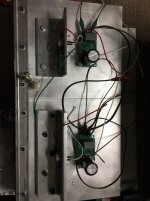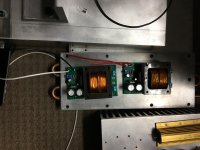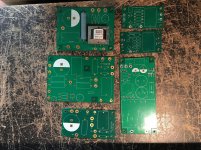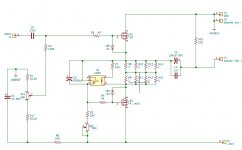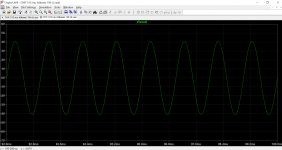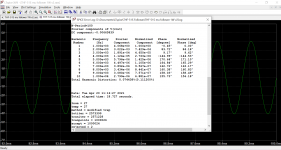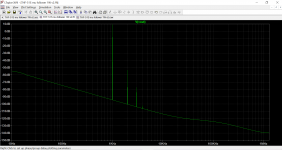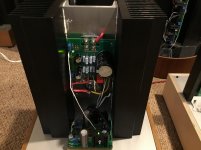Build them all, thats my motto. I've been following Ben down this rabbit hole. Only way to keep up with him is to build an open chassis so things can be swapped out with ease. Had boards made to make the process a little cleaner.
J113 buffer with PS
SIT Follower with Inductor
SIT Common Source with Inductor Load (the one in his initial 2SK180 thread)
Even did a BAF2015 with Inductor Load
separate -bias PS
SIT with Mu CCS
J113 buffer with PS
SIT Follower with Inductor
SIT Common Source with Inductor Load (the one in his initial 2SK180 thread)
Even did a BAF2015 with Inductor Load
separate -bias PS
SIT with Mu CCS
Attachments
Congratulations! I will be following with interest and will probably build something similar. Would the 2sk182es be a drop-in replacement? I have the thf-51 also.
The 2SK182es will probably work in the circuit. However you may want to do some testing and measuring.
Zen Mod in his Singing Bush amplifier development tested various Tokins. That amplifier is single ended common source but he did find variations in the distortion profiles. Variations in the distortion profiles of the Tokins in common drain are probably likely too.
Common source vs Common Drain
It's as what analog_sa, rickmcinnis, and MEGA_amp have said: build, compare, and find out what you like.
I have built single ended triodes as preamps and amplifiers in cathode bias (tube equivalent of solid state single ended common source with source resistor for bias), SIT preamp and amplifiers single ended common source, and now SIT amplifier (my 2SK180 amp) single ended common drain (follower).
One common characteristic of single ended common source amplifiers is their relatively high harmonic distortion. Levels of 0.5% or higher at 1W output is common and that can rise to 2%, 3%, or higher as the power output increases. The distortion may be predominantly second order but it can be noticeable and at some point it can be objectable. However for the most part it can and does sound good.
But then I listened to my 2SK180 follower driven by my Luminaria preamp. The biggest change that I noticed was a clarity that I had not noticed before with my other single ended amplifiers, yet the sweetness of the SITs was still there. Now the Luminaria is a Sony 2SK82 single ended common source preamp so it has its own second harmonic distortion but because of its operating point (high voltage low current), it is lower. So the preamp or voltage gain stage driving the follower can tailor the sound that you hear.
Here is a link to the distortion measurements of the Luminaria driving the 2SK180 follower:
25W Single Ended Hammond 193V Choke Loaded 2SK180 L'Amp
Mega_amp, that is great that you have tried many configurations. What are your impressions, preferences?
It's as what analog_sa, rickmcinnis, and MEGA_amp have said: build, compare, and find out what you like.
I have built single ended triodes as preamps and amplifiers in cathode bias (tube equivalent of solid state single ended common source with source resistor for bias), SIT preamp and amplifiers single ended common source, and now SIT amplifier (my 2SK180 amp) single ended common drain (follower).
One common characteristic of single ended common source amplifiers is their relatively high harmonic distortion. Levels of 0.5% or higher at 1W output is common and that can rise to 2%, 3%, or higher as the power output increases. The distortion may be predominantly second order but it can be noticeable and at some point it can be objectable. However for the most part it can and does sound good.
But then I listened to my 2SK180 follower driven by my Luminaria preamp. The biggest change that I noticed was a clarity that I had not noticed before with my other single ended amplifiers, yet the sweetness of the SITs was still there. Now the Luminaria is a Sony 2SK82 single ended common source preamp so it has its own second harmonic distortion but because of its operating point (high voltage low current), it is lower. So the preamp or voltage gain stage driving the follower can tailor the sound that you hear.
Here is a link to the distortion measurements of the Luminaria driving the 2SK180 follower:
25W Single Ended Hammond 193V Choke Loaded 2SK180 L'Amp
Mega_amp, that is great that you have tried many configurations. What are your impressions, preferences?
Hi Ben,
Here is where I'm at as I work for a similar follower output. I'm starting out with a CCS and can change to a Mu easily.
I'm keeping in mind that I will need to play with the VDS and Bias to find the distortion profile I'm looking for.
Thanks for sharing your journey 🙂
Here is where I'm at as I work for a similar follower output. I'm starting out with a CCS and can change to a Mu easily.
I'm keeping in mind that I will need to play with the VDS and Bias to find the distortion profile I'm looking for.
Thanks for sharing your journey 🙂
Attachments
What are your impressions, preferences?
Your original 2SK180 Common Source Inductor loaded was exceptional (still a work in progress). I managed to get the bias under control. I'm sure the giant heatsinks, the 1000VA transformer and 400KuF worth of power supply I'm using helped. I didn't seem to have any issues with runaway. Like you, I did my tests during the dead of winter. However I didn't have the buffer built when I tested it, so it was not driven properly, but the sound was spooky good...even connected directly to an iphone. I have yet to build the follower version, need a decent preamp, ordered the AKSA Lender boards to mate with it. It's all a lot of fun, appreciate you being a trailblazer, i'm just a copycat😀
If a power follower output stage contributes little of it's own sound, what is the advantage of using a SIT in a follower output?
Actually the SIT power follower is still the dominant piece, and generates
that 2nd harmonic many are fond of, but is more neutral than Common
Source mode.
I wonder what Nelson has to say about this. He has probably heard the most number of combinations.
I am fascinated by how the devices and topologies affect the sound. If you've read part 2 of Hiraga's article from 'that' AX issue, then it says you should have a monotonically decreasing harmonic profile, and probably not much about the 3rd harmonic. So, 2nd dominant, followed by third gives you the best sound. He even shows a portion of the music signal as input followed by different types of distortion added to the signal and what the output looks like over time. He shows that the harmonic profile described above preserves the signal in the time domain, whereas if you have lower second and higher order harmonics, then the signal visibly looks different in the time domain.
I found the above to be true, especially after I built the F4, which has that monotonically decreasing harmonic structure. It just sounds so musical. Adding an 01a (triode) DHT pre made things even better, which made me think "there is really some truth to more linear devices producing better sound." But then I built the BA-3, which has pentodes and not triodes, and it sounds even better. So, it is not just the devices, but the topology also. And ultimately, it might be what harmonic profile you are listening to and how it changes with level.
And Nelson has been talking about the phase of the 2nd harmonic as well, so it is not just the level of the harmonics, but also the phase. Fascinating, isn't it?
I am fascinated by how the devices and topologies affect the sound. If you've read part 2 of Hiraga's article from 'that' AX issue, then it says you should have a monotonically decreasing harmonic profile, and probably not much about the 3rd harmonic. So, 2nd dominant, followed by third gives you the best sound. He even shows a portion of the music signal as input followed by different types of distortion added to the signal and what the output looks like over time. He shows that the harmonic profile described above preserves the signal in the time domain, whereas if you have lower second and higher order harmonics, then the signal visibly looks different in the time domain.
I found the above to be true, especially after I built the F4, which has that monotonically decreasing harmonic structure. It just sounds so musical. Adding an 01a (triode) DHT pre made things even better, which made me think "there is really some truth to more linear devices producing better sound." But then I built the BA-3, which has pentodes and not triodes, and it sounds even better. So, it is not just the devices, but the topology also. And ultimately, it might be what harmonic profile you are listening to and how it changes with level.
And Nelson has been talking about the phase of the 2nd harmonic as well, so it is not just the level of the harmonics, but also the phase. Fascinating, isn't it?
Hi Botte,
That is fundamentally the same as my circuit except mine has the mu output connection and yours is straight CCS. One thing you should consider is the gate leakage current of the Tokin. Your R2 100K may be too large if your Tokin's gate leakage current is high.
I posted the simulated 45W distortion results previously. Here are the simulated 1W distortion results for comparison:
That is fundamentally the same as my circuit except mine has the mu output connection and yours is straight CCS. One thing you should consider is the gate leakage current of the Tokin. Your R2 100K may be too large if your Tokin's gate leakage current is high.
I posted the simulated 45W distortion results previously. Here are the simulated 1W distortion results for comparison:
Attachments
I'm getting micro amp level Gate currents in testing, and I always check the DC
across that resistor. So far, not a problem, and a little drift is not a big deal.

across that resistor. So far, not a problem, and a little drift is not a big deal.

I faced the same Gate currents issue when i was using 2sk77,then i chang to use lt3015 forb the base.
Last edited:
I'm getting micro amp level Gate currents in testing, and I always check the DC
across that resistor. So far, not a problem, and a little drift is not a big deal.

I have been using a 10k resistor in all my VFET/SIT builds after reading Michael Rothacher's L'Amp posts on the subject. I have to admit that I just did it and never measured the actual gate leak current.
So yesterday I got curious about the gate leak current of the 2SK180s in my 2S180 193V follower amps. First I looked up the Tokin specifications and they specified 100uA maximum at Vgs=-40V. Then I took some measurements over a span of several hours. The results are here:25W Single Ended Hammond 193V Choke Loaded 2SK180 L'Amp
What I found was that the gate leakage current increased during the time that I was monitoring it and it got as high as 143uA (1.43V across 10k resistor). So in common source mode it had a significant affect on the bias voltage.
I think I was just unlucky to get these two misbehaving 2SK180 Tokins.
My goal with the 100k was just to keep the input capacitor small so I can play with different types of caps I have on hand.
🙂
🙂
Hi Ben,
I have my version of the big VFET follower up and running.
Adjusting has been fun. I started with a CCS and found that the second harmonic was just about canceled. So I did what you did and changed to a Mu follower. I’m at just about exactly what you had. 50/50 split and with that I’m running the VDS at about 29v with a power supply of 65v. This gets me about .1% at 1W.
Thanks,
I have my version of the big VFET follower up and running.
Adjusting has been fun. I started with a CCS and found that the second harmonic was just about canceled. So I did what you did and changed to a Mu follower. I’m at just about exactly what you had. 50/50 split and with that I’m running the VDS at about 29v with a power supply of 65v. This gets me about .1% at 1W.
Thanks,
Attachments
Hi Botte,
It's good to see some real life numbers. What Iq are you running?
I've finished my latest project and my KP926 are still somewhere in transit, so I'll order some parts this week and start working on this amp too.
Ben
It's good to see some real life numbers. What Iq are you running?
I've finished my latest project and my KP926 are still somewhere in transit, so I'll order some parts this week and start working on this amp too.
Ben
I’m running 2.2A at 65V. I’m getting a 24deg C rise on the heatsinks.
It will definitely be a winter amp.
It will definitely be a winter amp.
Hi Ben,
I have my version of the big VFET follower up and running.
Adjusting has been fun. I started with a CCS and found that the second harmonic was just about canceled. So I did what you did and changed to a Mu follower. I’m at just about exactly what you had. 50/50 split and with that I’m running the VDS at about 29v with a power supply of 65v. This gets me about .1% at 1W.
Thanks,
Hi,
Are you using THF-51S?
Where can I get the PCB?
Thanks.
I've finished my latest project and my KP926 are still somewhere in transit, so I'll order some parts this week and start working on this amp too.
I'll be watching with interest...
- Home
- Amplifiers
- Pass Labs
- Single Ended Tokin SIT THF-51S Common Drain Mu Follower Amplifier, 45W?
